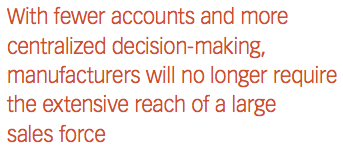When Care Models Collide
Pharmaceutical Executive
What you should know about integrated delivery networks.
Healthcare companies are being challenged to reduce costs while delivering innovative, quality care. A host of factors-shrinking reimbursement, penalties for quality shortfalls, more assertive payers, and the increasing transparency of provider pricing-are challenging traditional operating assumptions. Some of these changes are mandated by recent legislation, and others are market responses to this fundamental mandate for better quality at lower cost.
For pharmaceutical manufacturers, navigating this transition depends on understanding how to effectively engage healthcare delivery customers that look and behave differently. Specifically, rising cost pressures, stiffer financial penalties, and the imperatives of healthcare reform are forcing hospitals and health systems to develop new commercial models. One emerging tool is the integrated delivery network (IDNs) designed to aid the transition to a more value-based paradigm. Many health providers doing business with pharma are actively consolidating and/or creating alliances to develop them.
However, there is no common IDN model. Provider organizations vary in their development of and preparedness for a new business model. Some IDNs have well developed procedures for managing clinical variation and are assuming risk for a population, while others are just beginning to establish the infrastructure for managing populations and risk. And there are still others that are just trying to conduct business as usual.
Manufacturers are finding themselves selling into an uncertain, stormy environment that has drastically different business drivers, risk tolerance, and operating environments. As providers become larger, more integrated, and take on more risk, pharmaceutical manufacturers must develop commercial models that can adapt to this rapidly changing delivery landscape. In addition, focus will need to be given to their R&D models to ensure they are developing the data they need to demonstrate value to these new, more demanding customers.
The changing face of ‘Big Healthcare’
Although the healthcare delivery sector is in a state of turbulent change, one thing is certain: the drivers behind consolidation are here to stay, and IDNs will become more prevalent and influential. In 2012, the number of deals more than doubled those in 2009, and the largest IDNs in 2013 brought in multi-billion dollar revenues that rival Fortune 500 companies. It’s not just large provider systems getting larger-local hospitals are partnering up to increase regional market share as well. Even some academic health centers have entered the consolidation frenzy, most recently seen in the merger between the University of Arizona Health Network and Banner Health.
While IDNs are becoming increasingly prevalent, the concept isn’t new-some of the best known (like

Kaiser Permanente, Geisinger, and Mayo Clinic) have been around for decades. These organizations have been highlighted nationally as examples of efficient and coordinated healthcare delivery to which other provider organizations should aspire. Even these IDNs, however, have widely variable structures, governance, and strategies. A key part of their success is the culture they’ve been able to develop that supports their business models and strategy, built with significant investments in time, energy, and capital.
Four binding truths
Today’s evolving group of IDNs come in all shapes and sizes-the only common denominator is that they all own or manage multiple points of patient care. Some IDNs operate in local geographic areas, while others may be in markets across the US or even abroad. A central goal for most IDNs is to effectively manage the cost and quality of care, yet each organization is likely to take a unique and nuanced approach comprised of some or all of the following strategies:
Leveraging size to negotiate prices. A key driver behind healthcare consolidation is the desire to leverage volume to obtain better purchase terms. For pharma, this means fewer, larger accounts with greater market power. Broader use of group purchasing organizations (GPOs), and other cost controls are an outcome. In some cases, IDNs may expand their relationship with GPOs; other IDNs may choose to negotiate with manufacturers directly. This will have important implications for how manufacturers approach and segment their markets. Manufacturers may need to restructure their sales force and will need to build strategic account management capabilities to effectively target and engage these larger accounts.
Administrators play a greater role in product decision-making. To varying degrees, IDNs influence clinical decision-making by making administrative purchasing decisions. This means that decisions about which products to use are becoming more centralized. No longer left up to individual physicians, such decisions are increasingly made by committees comprised of physicians and administrators for whom institutional objectives may factor more significantly into decision criteria than had been the case.
Depending on the governance structure and degree of centralization of the IDN, these administrative decisions may apply to facilities and physicians across the network, including affiliated physician groups or outpatient centers. Manufacturers need to understand how product decisions are made within an IDN and be able to provide data that demonstrates not only the clinical value of their products, but also the economic value. Consolidation of providers into fewer, larger accounts means that the failure to “make the cut” with any one IDN can have significant financial implications.
Requiring care protocols to improve efficiency. Many IDNs are managing variation in cost and outcomes by creating and adopting care paths that define treatment protocols. Some protocols outline general clinical decision points, while others are detailed to the point of defining the specific products to be used. Understanding where products fit along care paths, how the protocols are being used throughout the IDN, and who makes these care protocol decisions will be critical for drug manufacturers going forward. Suppliers must differentiate themselves from competitors to avoid continuing pressure for commoditization, or being shut out of the care path completely.
Assuming risk for their patients. A growing number of IDNs and other large provider organizations are starting to consider taking on risk in the form of bundled payments and population health management. Some of this is driven by opportunity-CMS and the Center for Medicaid & Medicare Innovation (CMMI) have created a series of pilot models that involve various stages of risk management. Others are engaging with commercial payers and developing models for specific populations and subpopulations. As IDNs assume risk, they will look to manufacturers to do the same-and manufacturers need to consider how they will respond.
Pharma’s response
Regardless of the strategies and programs IDNs ultimately adopt, manufacturers can be certain that there will be an increased need to demonstrate economic and clinical value. Manufacturers will also be dealing with new decision makers as physicians’ influence is shared with administrators and executives. Delivering value to this highly variable customer base requires a differentiated approach for each IDN. In order to successfully segment and engage customers, strategic account management capabilities need to be embedded throughout the organization. This should be accompanied by restructuring sales models to enable selling in a more complex environment. Finally, manufacturers must reevaluate the value that they offer to their customers, adjusting their R&D strategy and investments.
Strategic account management
There are compelling reasons for adopting strategic account management strategies for approaching IDNs. While all healthcare delivery organizations are focused on reducing cost and improving quality, each customer organization has unique characteristics that can have important implications for how to effectively approach sales. Some characteristics of IDNs, such as number of facilities, may be easy to discern. Others, such as the use of centralized purchasing, risk tolerance, and governance structure, will require in-depth understanding gained from relationship building and market intelligence. It’s necessary to understand their business drivers, identify their key decision makers, and discern their current risk profile. Ultimately you must be able to demonstrate value in terms that matter to each audience that is a part of the purchasing process. To do that, it’s critical to understand what those criteria are.
Strategic account management is more than high volume physician sales-it requires continuous management of complex relationships, multiple contracts, and different buying preferences across different types of provider organizations. The role straddles sales and marketing and requires integration across boundaries-within the customer and within the pharma organization. To be successful, strategic account management must have relevant and valid insights from strategic marketing. Real strategic marketing must start with an analysis of market trends, with the intention of determining current unmet clinical and economic needs-and predicting future needs as well. Strategic marketing also requires an ability to see the “white space” opportunities inherent in such trends. It also requires the organizational competencies to incorporate this insight into critical business decision processes such as portfolio management and product development.
Revisiting the sales model
With fewer accounts and more centralized decision-making, manufacturers will no longer require the

extensive reach of a large sales force. This leaner sales force will need expanded capabilities to succeed in a new, more complex sales process. Prioritizing each account based on its potential and then working to optimize the value of the account requires a level of business acumen not commonly found among traditional sales reps trained to focus on a product’s features and benefits. The core competencies for reps focused on IDNs will need to be redefined-they must have the ability to engage key decision makers with sophisticated scientific understanding of their products and the financial benefits they offer. Working sessions and training programs for sales staff are necessary to upgrade skills and translate them into practical applications.
As IDN account management becomes an important function within the sales team, accountabilities and reporting relationships will need to be redefined to ensure that there is clarity around roles and responsibilities. New performance metrics will be needed to measure the quality of account management rather than just the volume of sales.
Executing in an IDN world: Two critical steps
Economic and clinical value drives a market-based commercial model. Manufacturers must identify what constitutes value to all relevant stakeholders-including payers, physicians, administrators, and patients. Absent any evidence supporting the economic and clinical value of the product, manufacturers will be left to compete on price. To avoid engaging in price wars, pharmaceutical companies must demonstrate value with data, and communicate the value proposition in terms that are meaningful to their customers.
Consider value in early product development. This may require developing a strong economic and clinical value message earlier in the product development cycle. In addition to randomized clinical trials, evidence underpinning the value story will need to be broad, such as post-market longitudinal studies, patient reported outcomes, and other sources of real world evidence. The value proposition needs to communicate the net benefit of pharmaceuticals in the broadest “real-world” context (i.e., clinical, economic, quality of life, and productivity measures) relevant to the customer’s strategic objectives.
Companies must ensure that delivering value is at the core of all activities, from portfolio investment decisions, to product development, and extending across the entire product life cycle. Designing and developing products and services that fit with your customers strategic requirements-and are profitable to you-requires collaboration across multiple parts of the organization. This includes R&D incorporating added value into the product design at an early stage. R&D should also consider real-world patient issues-such as elderly age cohorts, multiple chronic conditions, and poly-therapy.
As providers pursue strategies that focus on treating a certain population, whether by geography or disease state, pharmaceutical manufacturers will need to understand how their products serve that population. They may need to invest in targeted therapeutics/personalized medicine based on biomarkers. The goal would be drug-diagnostic companions able to demonstrate high value in small subsets of the population that are of particular interest to the customer. By bringing their disease expertise to bear, manufacturers have opportunities to help providers stratify populations for different risk profiles or treatment responses in order to better manage scarce resources.
Identify ways to create partnerships. As providers work to better manage costs, they will find value in manufacturers that are experts in a therapeutic or diagnostic area. A customer’s needs may not be addressed simply through a new product alone. Pharmaceutical companies need to explore whether to develop “service wraps” that provide more complete solutions across the continuum of care. They can differentiate their products and portfolio by offering value-added services that help providers manage certain segments of their population. By leveraging their disease knowledge to create products and services, pharmaceutical companies can gain a competitive edge and dominate a therapeutic area.
Manufacturers that are able to demonstrate ownership of a therapeutic area through a portfolio of effective products and services may be in a position to consider sharing risk with payers and providers for patient outcomes. In an environment where all stakeholders are working to manage costs and quality, this will be an effective way to differentiate on value. Important questions to consider when determining whether to take on risk include: Are providers looking for a partner to share the risk they have assumed as part of a capitated payment model? How confident are manufacturers that they can deliver products or services that help customers meet their goals? How much “skin” are pharmaceutical companies willing to put in the game? Are internal processes established to design, approve, manage and measure a risk-based arrangement where significant revenue is on the line and where those revenues might be deferred to some point in the future?
Conclusion: Stay flexible
The market and regulatory forces driving providers to form IDNs will continue to intensify as managing healthcare costs and quality continues to be a priority. This means that a variety of different care models will be competing in the US market for the indefinite future. Manufacturers should invest in developing new capabilities and R&D priorities that allow them to be nimble and responsive to providers, regardless of their current operating model and risk profile. By doing so, manufacturers will ensure that their models reflect the new market realities and they are equipped to meet rapidly evolving customer goals.
Kim E. White, MBA, is a Senior Consultant at Numerof & Associates Inc. She can be reached at kwhite@nai-consulting.com. Christen Buseman, PhD, MPH, is a Research Analyst at Numerof & Associates Inc. She can be reached at cbuseman@nai-consulting.com.

The Misinformation Maze: Navigating Public Health in the Digital Age
March 11th 2025Jennifer Butler, chief commercial officer of Pleio, discusses misinformation's threat to public health, where patients are turning for trustworthy health information, the industry's pivot to peer-to-patient strategies to educate patients, and more.
Navigating Distrust: Pharma in the Age of Social Media
February 18th 2025Ian Baer, Founder and CEO of Sooth, discusses how the growing distrust in social media will impact industry marketing strategies and the relationships between pharmaceutical companies and the patients they aim to serve. He also explains dark social, how to combat misinformation, closing the trust gap, and more.

.png&w=3840&q=75)

.png&w=3840&q=75)



.png&w=3840&q=75)



.png&w=3840&q=75)



















